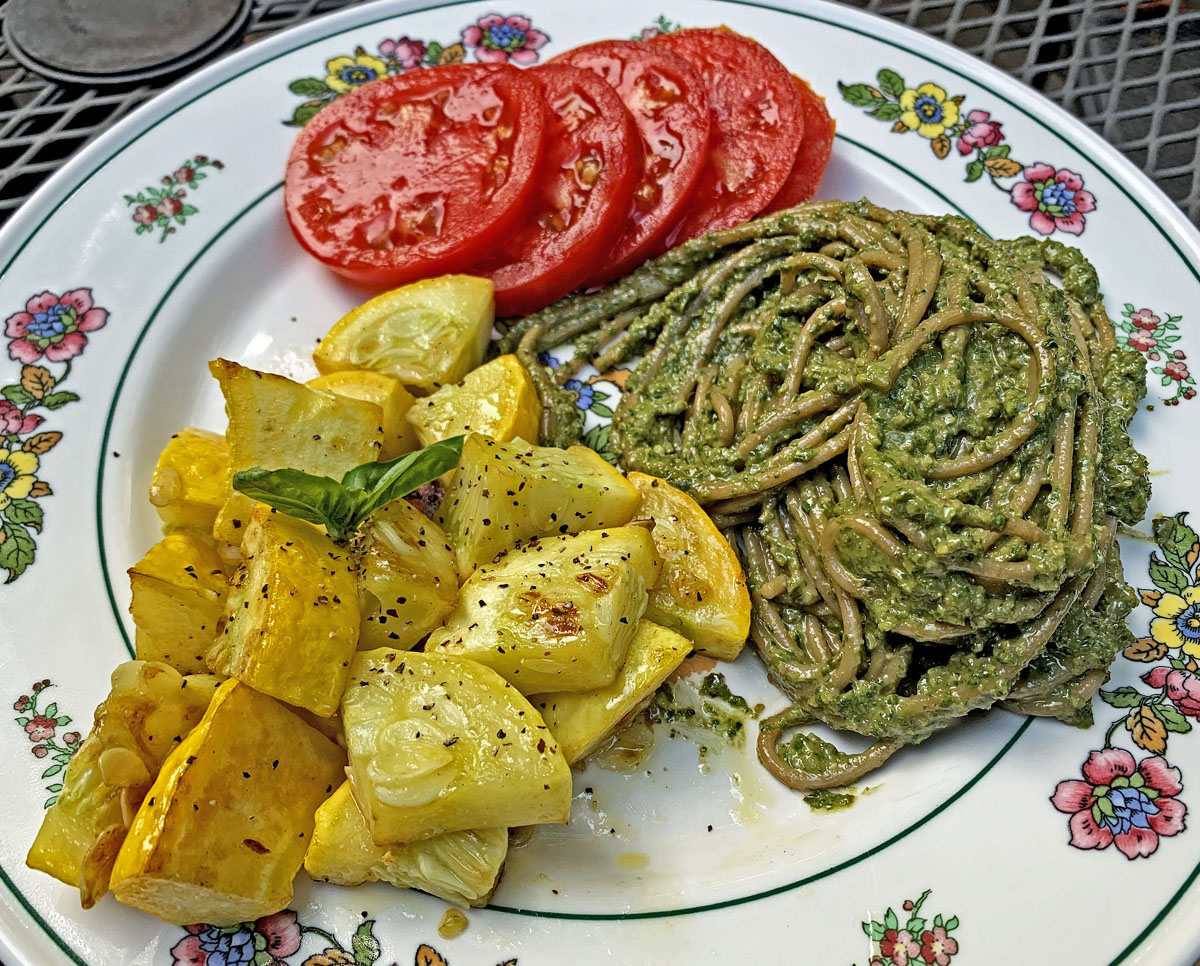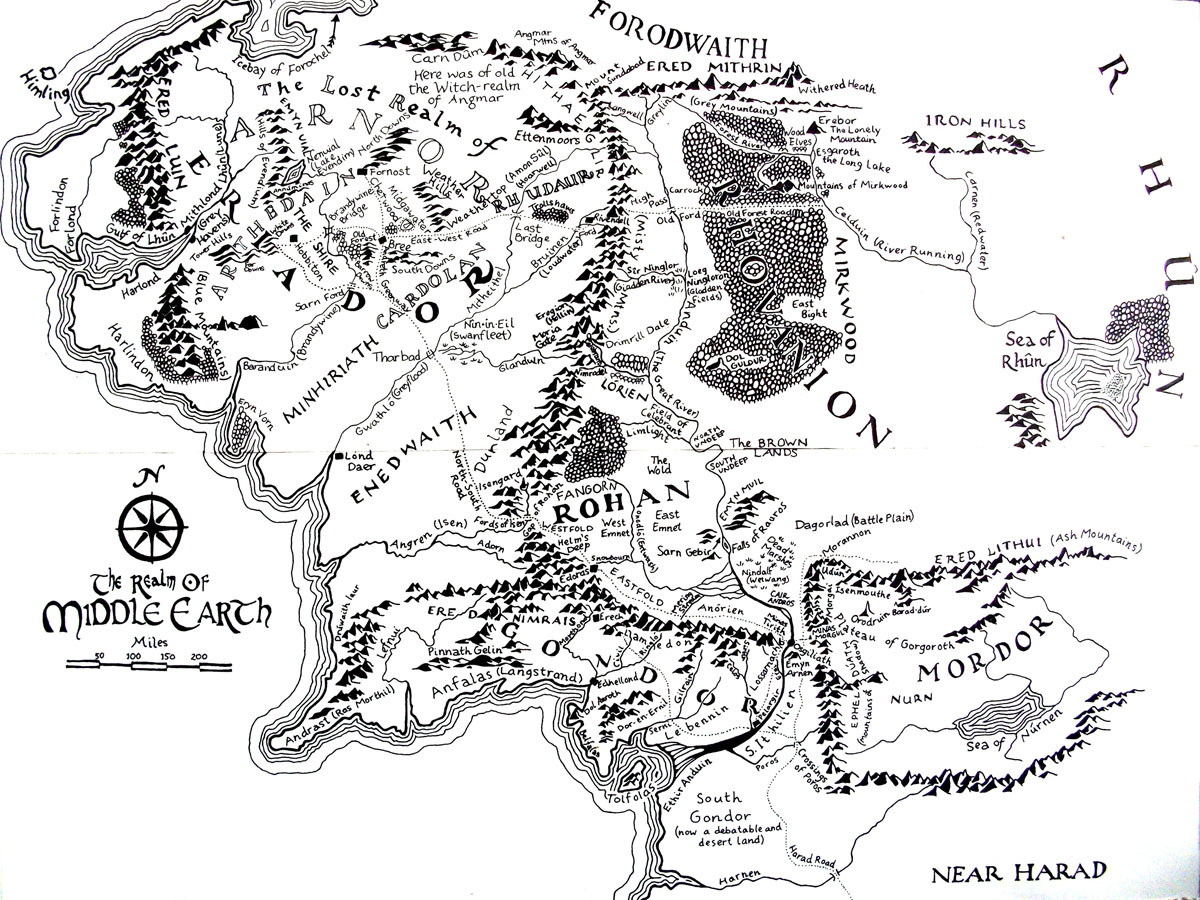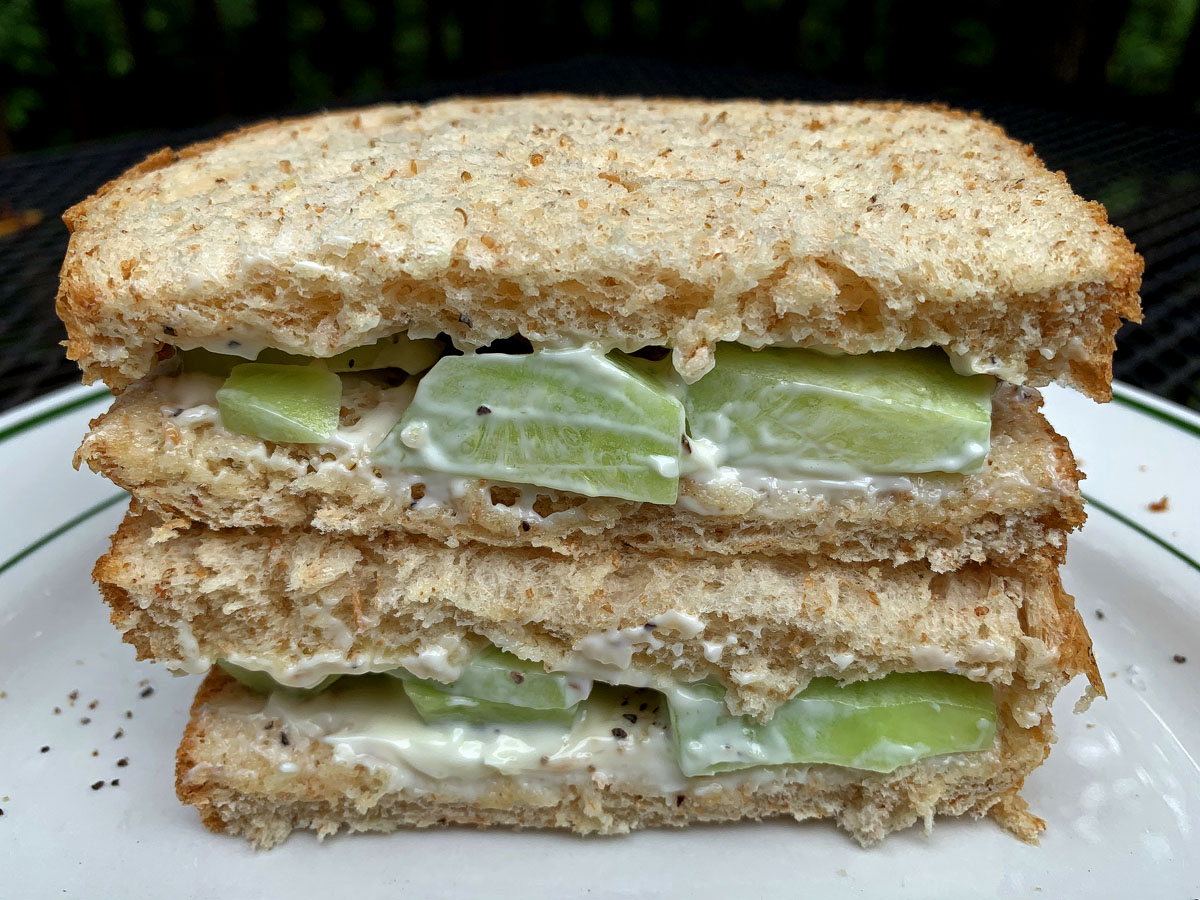
Vegetables don’t like to be picked in the heat of the day. Early morning is the best time. But basil wants to be clipped five minutes ago, so this basil, squash, and tomato went from the garden to the supper table in 35 minutes.
Watching a bewildering world from the middle of nowhere

Vegetables don’t like to be picked in the heat of the day. Early morning is the best time. But basil wants to be clipped five minutes ago, so this basil, squash, and tomato went from the garden to the supper table in 35 minutes.

It was 1976, I believe, when I bought a copy of the 1943 edition of Irma Rombauer’s The Joy of Cooking at a junk shop. I am not hard on books, so I’m sure that the book was in fairly rough condition when I bought it. Over the years, though, the fabric peeled off the spine, and the covers came loose. Recently I found another copy of the 1943 edition on eBay and bought it for $28.
Why the 1943 edition? The 1943 edition is the wartime edition, which emphasized frugality and cooking from scratch. There have been many editions of The Joy of Cooking (see the Wikipedia article). According to Wikipedia, the 1936 edition emphasized meals that could be made in 30 minutes or less, using frozen and canned foods (yuck). The 1951 edition sounds interesting, though I have never seen a copy. Later editions, as far as I’m concerned, are probably poor references for truly traditional home cooking in America, which is what this book is good for.
In the 2009 film “Julie & Julia,” there is a funny scene in which Julia Child (played by Meryl Streep) encounters Irma Rombauer in a publisher’s office. Rombauer is presented as dowdy and a bit of a hick. Compared with Julia Child, no doubt she was. But, in my opinion, though learning to cook other nations’ cuisines competently is a skill greatly to be desired, there is no shame in honoring, loving, and preserving one’s native cuisine. The 1943 edition of The Joy of Cooking is the best reference I have ever seen for traditional American cooking.
I rarely follow any recipe exactly. But I do consult many, many recipes, just to get a concept before making my own version. My modifications are usually about making things healthier, with a bias toward California cuisine and Mediterranean cuisine. Though just about every recipe in The Joy of Cooking 1943 is made from scratch, she does use pantry staples that we all still use — tinned tomatoes, tinned salmon, and cracker crumbs, for example. (I don’t keep crackers in the house because I like them too much, but I recently bought some Ritz crackers — for the first time in my life, as far as I can recall — to make a traditional squash casserole.)
Part of the value of The Joy of Cooking 1943 is its completeness. You’ll find a reference for just about everything your grandmother (or great-grandmother) used to make. I was shocked a few months ago, though, when I discovered that there is no recipe for pimento cheese, which is an American classic.

The Reichstag burns, Feb. 27, 1933.
It’s impossible to read William Shirer’s The Rise and Fall of the Third Reich without making comparisons to Donald Trump. To risk an unattractive analogy, to compare the two is like comparing a hot little pustule ripe for popping to a deadly case of gangrene. Donald Trump is stupid, lazy, cowardly, petty, and gratuitously cruel. Whereas Hitler was a political and military genius, and a total psychopath. Hitler had a plan — a diabolical plan that he had the discipline and nerves to execute.
At present I am 450 pages into the 1,250 pages of Third Reich. I’ll have more to say about this impressive book later. But the German election of 1933 is on my mind now because the next American election is just over three months away. We already can see that Trump’s strategy for Nov. 3 is a crummy, timid imitation of the German election of 1933.
Trump wants as much disorder in the streets as possible between now and November. The hot spot at the moment is Portland, where noisy and naive protesters, probably with inexperienced leadership, are up against heavily militarized police and uninvited federal agents. Trump will continue to call for “law and order” to stop the “violent Marxist thugs,” saying that only he can make us safe. Nancy Pelosi, who knows her history and is more inclined toward understatement than overstatement, makes the comparison to Hitler: “Unidentified stormtroopers. Unmarked cars. Kidnapping protesters and causing severe injuries in response to graffiti. These are not the actions of a democratic republic. Trump and his stormtroopers must be stopped.”
Trump cannot win — or steal — the November election without treachery in some form. The question is: How far will he go?
The complete story of the Reichstag fire is still in dispute. Hermann Göring once boasted that he had set the fire, though Göring denied that at Nuremberg. Whatever happened, the Nazis wasted no time in blaming a Communist conspiracy and using the Reichstag fire to try to swing the election, which came six days later. The Prussian government declared:
“Government buildings, museums, mansions and essential plants were to be burned down…. Women and children were to be sent in front of terrorist groups…. The burning of the Reichstag was to be the signal for a bloody insurrection and civil war…. It has been ascertained that today was to have seen throughout Germany terrorist acts against individual persons, against private property, and against the life and limb of the peaceful population, and also the beginning of general civil war.”
The election was March 5, 1933, and it was the last democratic election in Germany during Hitler’s lifetime. The Nazis got 44 percent of the total vote.
FiveThirtyEight’s national polling average, as of July 16, shows Trump with 41.2 percent. To take control with 41.2 percent support, a level of treason and treachery would be required that I don’t think Trump is capable of even conceiving, let alone carrying out. (We should keep in mind, though, that Putin, who owns Trump, is much more competent.) Nor is the American democracy as weakened and exhausted as Germany’s was in the years after World War I. Trump has goons (many of whom have already been brought to justice), but Trump has no Göring.
Just listen to the sadistic voice of Göring, in Frankfurt the day before the elections:
“Fellow Germans, my measures will not be crippled by any judicial thinking…. I don’t have to worry about justice; my mission is only to destroy and exterminate, nothing more! … Certainly, I shall use the power of the State and the police to my utmost, my dear Communists, so don’t draw any false conclusions; but the struggle to the death, in which my fist will grasp your necks, I shall lead with those down there — the Brownshirts.”
In comparison with that, Trump and the even the sadistic Stephen Miller are feckless amateurs. But they will try to keep their power, and their only possible game is a dirty one.
The protesters need to learn some history, too. To march in great numbers and to make as much noise as possible is perfectly good protesting. But to break things or to make any use of fire before such a dangerous election is very foolish.
Update 1: From the Washington Post (be sure to watch the video, which went viral):
A Navy vet asked federal officers in Portland to remember their oaths. Then they broke his hand.
Update 2: Heather Cox Richardson’s Facebook post last night makes the same point that I made in this post yesterday morning. As she puts it: “It seems clear that the Trump campaign — which got a new director last Wednesday — is going to make its case for reelection on the idea that there is violence in America’s cities that must be addressed with federal force, and that only Trump is willing to do so.”
Heather Cox Richardson on Facebook
Update 3: New York Times:

By the time summer leaves us, most of us are tired of summer. But would we ever tire of summer mornings? I think not.
These are iPhone XR photos. The XR camera is so good, and so handy, that I think I will trade it this fall for an iPhone 12, partly to get an even better camera, and partly to get support for T-Mobile’s low-band (600Mhz) 5G, which sounds very promising for rural areas without a lot of cellular towers. The 600Mhz band of 5g uses frequencies that formerly were used by broadcast television. Propagation at those frequencies is excellent. I still use my heavy Nikon D2X camera, by the way. The Nikon is still best for more formal and more carefully composed photos, especially when the camera is on a tripod. But the newer iPhones are astonishly good at snapshots (and video).




A screen capture from the Washington Post web site
When a newspaper is prospering and newsroom budgets are growing, that newspaper can have itself a food department. When revenue is sliding and newsroom budgets are being cut, the food department is the first to go.
If the Washington Post had a notable food department ten years ago, it never caught my attention. In the last few years of my newspaper career (at the San Francisco Chronicle), there were two outstanding newspaper food departments in the U.S.: the New York Times and the San Francisco Chronicle. The New York Times in those days poached a writer or two from the Chronicle. (To have your staff poached by the New York Times is a high compliment to a secondary newspaper.) If the Chronicle still has a food department today, I’m sure it’s tiny. Mostly the Chronicle now writes about restaurants. (Secondary and tertiary newspapers these days cover restaurants better than they cover city hall.)
A newspaper food department requires spending some capital. You have to provide a well-equipped test kitchen. You need a special studio for food photography. You need some sort of dining room for tastings and sharing and an assortment of photogenic serving vessels for photography. On the expense side, you’ll be buying all sorts of expensive groceries every week. You need a staff with special training and food-world credentials. I always found the food department to be the happiest department at the paper. I loved to drop in on them and see what they were cooking.
The Washington Post, of course, and the New York Times are now rolling in money. Life has been hell at every other newspaper in the country, but fortunately this country has two strong newspapers left. Even if I didn’t know that the staffs and budgets are growing at the Times and the Post, the work of their food departments would reveal that they’re rich.
Another thing I notice about the Washington Post’s food department is that they are doing superb food photography, as good as the New York Times. It’s a safe bet that, when the Post expanded its food department, they aimed to beat the New York Times. It doesn’t matter to me who is winning. They both are doing beautiful work.

I first read The Lord of the Rings almost 50 years ago. Subsequently I have reread it at least twice. I often have wanted to do another rereading, but as Bilbo is preparing for his birthday party, I realize that I can quote many of the next lines before I turn the page. It could almost be a parlor game: What does Gandalf say next? Having failed yet again to find a good novel that I haven’t read, I’ve embarked on my fourth reading of The Lord of the Rings. I just finished the first volume, The Fellowship of the Ring.
I still know the story by heart, of course. We all do. But this is the first time I’ve reread these books since my retirement more than 10 years ago. In those 10 years, I’ve read more about Tolkien including a book about the Inklings, I’ve read some of Tolkien’s letters, I’ve read a good bit on linguistics and prehistory, I’ve written two novels and part of a third, and — most important — I’ve hiked in remote places in the British Isles. It even helps to have visited Oxford last year, since that’s where these books were written. I’m finding that this fourth reading is rewarding for new reasons — savoring Tolkien’s use of language, admiring his scholarship, and marveling at his imagination.
One thing that has surprised me, though, is how much I’m enjoying the walking, walking, walking. Tolkien’s descriptions of terrain, sky (including the night sky), and weather are extraordinary. Having now hiked in moor, bog, and woodland and having ascended long, rocky, heather-covered ridges to the rainswept tops of wild mountains, I can now appreciate what previously was lost on me. It’s a travelogue, and it’s Tolkien’s descriptions that make Middle-earth so real. I never found the perfect pub (I hope to keep trying), but the provincial hotels of Scotland (such as the Royal Hotel at Stornaway) are almost as much fun as the Prancing Pony inn at Bree would be.
Before I start volume 2, The Two Towers, I am going to read William L. Shirer’s The Rise and Fall of the Third Reich, which Ken recently finished and highly recommends. It’s a big tome, 1,250 pages. It’s the sort of book that will be kept on a prominent shelf for reference, so I bought the hardback 50th anniversary edition, which was released in 2011. Ken wrote a good comparison of Trump and Hitler, on how they’re alike and how they differ, which I would like to reproduce here later, with Ken’s permission. These three evil characters occupy the same dark space in our minds where we store our dreads and icons of depravity — Sauron, Hitler, and Trump.
Speaking of Trump, each day we learn something new and horrifying about his criminality and treason. I haven’t felt that I have anything to add by posting about politics here, though, because I think that the responsible media and the responsible commentariat are getting it right. I still don’t understand, though, why Republican senators don’t talk Trump into resigning so that the Republican Party can try to save itself, and its hold on the Senate, by putting up another candidate. But then again, it is with Trump as it was with Hitler (and Sauron). To good people (and good hobbits) who are working with good information, such depravity is incomprehensible.

Here in the U.S., cucumber sandwiches are thought to be an English thing. I’m not sure if that’s true, though it sounds reasonable, and stores here sometimes sell what we call “English cucumbers.”
In any case, when I was a boy in rural North Carolina, cucumbers were plentiful, but I had never heard of a cucumber sandwich. Tomato sandwiches were the only kind of garden sandwiches we knew. I probably first got the idea of cucumber sandwiches from literature. For years they’ve been staple when good cucumbers are to be had and if I’ve bought store-bought bread in a moment of weakness. The cucumber in the photo was picked yesterday at dusk. It went straight into the refrigerator and spent the night there.
The tomatoes are coming along, but I’m still some days away from the first tomato sandwich. I’ll have to buy another loaf of bread.
Several varieties of cucumber are grown in these parts, but I grow only old-fashioned pickling cucumbers. I haven’t pickled any for several years, but if the cucumber harvest exceeds what I can eat fresh, then I’ll make some refrigerator pickles.

Periodically I go on a tear about Internet security. I take a look at everything — the browser I’m using, the browser’s security plug-ins, my Mac’s firewall, and pretty much everything I can think of. I check to see if there’s anything new that might help.
The Brave browser is pretty new. Version 1.0 of the browser was released last year. The browser code is based on Google’s Chrome. Brave claims that it is faster and more secure than Chrome. Brave even internally supports the Tor secure-browser network. You can open a Tor window in Brave.
In the browser business, there are no saints, and there never has been. Netscape, Microsoft’s Internet Explorer, Mozilla, Firefox, Opera … I’ve used them all at one time or another, and all have had their failings and foibles. Brave is no different. A few months ago Brave was caught trying to steer web traffic toward its money-making sites, which have something to do with encrypted currency. Brave apologized, though, and cleaned up their act.
I took a fresh look at Firefox, and I was appalled. Firefox was slow and was full of memory leaks. But Brave has been running nice and clean for a week now. Fewer security plug-ins are needed with Brave, because Brave takes care of many security issues by default, no plug-ins needed. Switching to Brave is easy if you’re a Chrome user, because it is compatible with Chrome. I easily moved my bookmarks and saved passwords to Brave.
Like it or not, Chrome is the most advanced browser, not least because it’s based on Google’s Chromium open-source software project. That’s how Brave is able to make use of the Chromium code base. But Google, being Google, is evil, and I’ve always distrusted Chrome, knowing that Google makes software decisions based on what makes people money on the web, not on what provides the best security for browser users.
I continue to use Safari, but only for Facebook. I detest and distrust Facebook, but I’ve not yet quit it. I keep Facebook running in a separate browser to keep it more isolated. And, as I mentioned in an earlier post, I’m now using OpenVPN, with the VPN server running on my own virtual private server.

Click here for high-resolution version.
I had not previously encountered borage. I think it is not as commonly used in the U.S. as it is in Europe. But we grew some this year in Ken’s herb trough, starting from seeds in a variety pack of favorite German herbs that I bought on Amazon. The borage is blooming now, with cheery little star-shaped flowers. Its taste is a bit like cucumbers, and it works well in soups and salad dressings.
Today Apple released a teaser for their Apple TV production of Isaac Asimov’s Foundation, which we will get to see in 2021.
I have read Foundation three times, I believe. It’s bound to present a challenge for filmmaking, and they’re bound to have to improvise. As beautiful a piece of fiction as Foundation is, I often have laughed about how nothing really happens. The story mostly consists of smart people sitting in boring rooms and talking. I’m hoping they’ve figured out how to make a film of it.